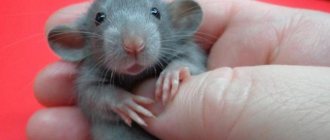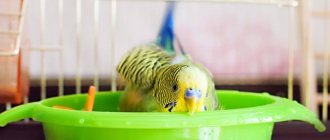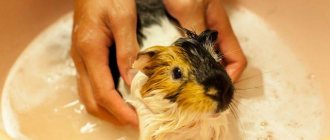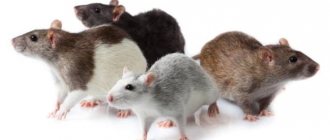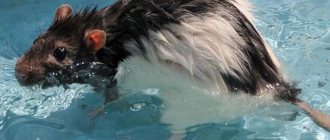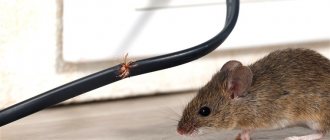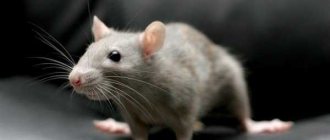- home
- Rat
- Care
07/06/2019 Monitoring the appearance of the animal is the unspoken responsibility of the owner. Many rodent owners are interested in whether it is possible to wash a rat at home. The answer is yes, but it is important to understand that this animal itself is very clean. The conditions under which a rat needs to be bathed and the details of this procedure are useful knowledge for the owner.
Is it possible to bathe rats
Some rat owners believe that they should not bathe their furry rats because they are afraid of water and do not know how to swim. Such fears are unfounded. After all, the wild relatives of cute rodents feel great in the aquatic environment - they swim, frolic and even hunt in reservoirs. Therefore, bathing will bring not only benefits to your pet, but also positive emotions.
The main thing is to act carefully during hygiene procedures and not harm your pet. You will have to prepare especially carefully for your first swim. Perhaps your pet will start biting or scratching out of habit. In such a situation, it is better to interrupt the water procedures and postpone washing until the next day.
When your pet is taking a bath, you need to make sure that water does not accidentally get into his ears. When deliberately diving, rodents manage to block the ear canals. But if the rat does not have time to do this, and the fluid gets into the ears, the fluffy one will most likely face otitis media.
Gluttony
Perhaps, scientific rats managed to participate in all the sins of humanity (with the help of scientists, of course). Such a primitive sin as gluttony was also not spared. For its full implementation, the brothers Louis and Theodore Zucker bred special genetically modified rats that proudly bore the names of their creators.
In fact, the whole purpose of Zucker rats was to consume food throughout their lives. They had an increased sense of hunger and could weigh twice as much as their unmodified ancestors. The rats paid for their sins in this life: they had high cholesterol levels in the blood and a whole bunch of diseases.
Experiment No. 9
When should you wash your rat and how often?
Experienced rat breeders recommend bathing animals no more than 2-3 times a month. You can also carry out unscheduled washing in the following situations:
- Parasites were found in the animal’s fur;
- the pet is heavily soiled in its own waste, this is especially true if the rat suffers from a gastrointestinal disorder;
- the rodent's fur has a sharp, unpleasant odor;
- after a walk outside, the pet may get dirty or pick up ticks and other parasites;
- fluffy refuses to take care of his hygiene on his own - in general, rats are very clean, but there are exceptions;
- after contact of a rat with a stranger or animal, the foreign smell may be unpleasant for the animal;
- on the eve of an exhibition or any other important event.
It is also imperative to bathe a sick or older animal more often, which, due to physiological characteristics, is no longer able to care for itself.
"Universe-25"
One day, Dr. John B. Calhoun decided to create a mouse paradise. He took a tank two by two meters, installed ceilings in it, laid a system of tunnels with individual compartments and drinking bowls, and at the beginning of 1972, he released four pairs of healthy, genetically flawless mice into this paradise. The tank was always +20 oC, every month it was cleaned and filled with food and nesting material.
Universe 25, as Calhoun called the tank, was in a golden age. A hundred days later, realizing their happiness, the rodents began to multiply wildly. The population doubled every 55 days, and no expulsion was expected for the Fall.
However, even at the moment of its creation, the “universe” was doomed. After all, number 25 was not chosen by chance. This was already the 25th experiment on rats and mice, and each time heaven turned into hell. The mice, which had multiplied to 600 individuals by the 315th day, already categorically lacked space.
Society began to rapidly collapse. Curious classes were formed: “nonconformists” who huddled in the center and regularly attacked nest owners, “beautiful” males who were not interested in reproduction and looked after themselves exclusively, and, finally, the “middle class” who tried to maintain the familiar at any cost. way of life Violence, sin and even cannibalism flourished in the tank.
Eventually, 90% of the females of reproductive age left the population and settled in isolated nests at the top of the tank. On the 560th day, Universe-25 was effectively finished. The population peaked at 2,200 individuals, the birth rate fell, and rare pregnancies ended in the killing of the cubs. The increased mortality did not save paradise: the last eight mice died one after another, never returning to their usual roles or trying to have babies!
In his work “Population Density and Social Pathologies,” Calhoun, along with “Universe 25,” buried all of humanity: “Even before we run out of resources, people will suffocate in their cities!” I would like to say: can’t wait! But…
Experiment No. 4
Preparation for water procedures
To prevent bathing from being chaotic, you should prepare in advance to perform hygiene measures. This will help both owner and pet feel more confident and relaxed.
Accessories
To bathe a rat, you need to prepare the following bath accessories:
- 2 shallow basins;
- a clean towel or soft baby diaper;
- a small washcloth (you can use a small piece of foam rubber or a cloth);
- a toothbrush with soft bristles.
Some rat owners ignore the use of a special bathing container, since washing their pet under running tap water is much more convenient.
However, this approach is quite dangerous, since the likelihood of liquid getting into the furry’s ears, eyes and nose greatly increases. In addition, there are often interruptions in the water supply, and icy or, conversely, very hot water may suddenly come out of the tap.
Bathing products
It is not recommended to wash rat fur with regular shampoos. Human hygiene products are too aggressive for the delicate skin of rodents and can cause irritation or dandruff. Therefore, it is better to buy a special rat shampoo, for example:
- Beaphar;
- Veda;
- Celandine;
- Le Artis;
- Shustrik.
Such products are inexpensive - in the range from 100 to 500 rubles. Moreover, one bottle lasts for about a year. In addition, most pet shampoos for rodents contain an anti-flea and tick component.
If your nearest pet store does not have a special shampoo for rats, you can order it online. Online stores offer a wide selection of specialized products for rodents.
Water level and temperature
To make swimming comfortable, you need to take care of the water temperature in advance. Ideally, the indicator should be +36-38ᵒС. It is best to use a special water thermometer to measure temperature. If the device is not at hand, you can immerse your elbow in the basin - the liquid should be warm, but in no case hot.
The water level in the improvised bath should be 3-5 cm - it is better to focus on the size of the rat. The main criterion is that the pet must calmly reach the bottom of the container with its paws, otherwise the animal may panic and try to escape from the basin.
For the psychological comfort of the fluffy, it is recommended to install a ladder in the bath, along which the pet can, if necessary, leave the container on its own.
Some rats love water from birth and are ready to swim every day. In such cases, it is allowed to pour more liquid into the basin so that the pet can frolic to its heart’s content and swim freely. Only the owner must closely monitor the rat, and at the first signs of fatigue, pull the animal out of the water.
Supermouse
In 2007, Richard Hanson and Parvin Hakimi of Case Western Reserve University in Ohio modified the mouse genome and bred about 500 supermice that were several times more resilient than their relatives.
Not only could the mouse superheroes run without rest for six hours, while the average mouse runs out of steam after half an hour, but they also lived longer, maintained reproductive abilities into old age, and also consumed 60% more food than the control group, while while remaining leaner and more athletic.
A remarkable experiment not only proved that by modifying just one gene it is possible to significantly speed up the metabolism of a living being, but also that nothing like this will happen to people in the near future. The special commission found it unethical to even think about it. So don't even think about it!
Experiment No. 6
How to properly wash a rat
In order for bathing to be successful, you will need to familiarize yourself in advance with the procedure for carrying out hygiene procedures. The main thing is to act consistently and confidently.
Bathing
To bathe, you will need to fill 2 basins with water at once. In one, you will need to bathe the rat using shampoo. And in the second, with clean water, you will need to immerse the animal to thoroughly rinse the fur. It is better to carry out the procedure in the bathroom or in any other room protected from drafts so that the animal does not catch a cold.
Before washing, you need to make sure that the pet is in a good mood, calm and does not mind spending time together with the owner. When the rat is ready, you will need to follow a few simple steps:
- Carefully take the fluffy in your hands and bring it to a bowl of water. If the animal sees the container for the first time, you need to let him sniff the bath.
- Carefully immerse the rat in the water, while slightly raising its muzzle.
- Wait 1-2 minutes, then gradually remove your hand so that the fluffy touches the bottom with its paws.
- Pour a small amount of your chosen shampoo onto wet palms and lather.
- Gently work the animal's fur with your hands, paying special attention to the back half of the body - if the animal is heavily soiled, it is better to use a small washcloth or cloth.
- Place the rat in a container of clean water and thoroughly rinse the fur to remove any foam.
You will also need to clean the animal's tail, this is especially true for males. To clean, you need to treat the tail part with a soft toothbrush, moving from the base to the tip. In this case, you need to act without pressure and under no circumstances rub the delicate skin.
If the rat itself is clean, and only the tail is dirty, it is not necessary to bathe the pet completely. It is enough to slightly soak the stains by applying damp cotton swabs for 5-10 minutes. After that, also treat the tail with a toothbrush and rinse with clean water. At the end of the procedure, you will need to wipe the ponytail with a towel and treat it with baby cream.
Drying
Rats are prone to developing colds. Therefore, after bathing, the animal’s fur should not remain wet; it should be dried as soon as possible. A towel or any soft fabric that absorbs moisture well is perfect for these purposes.
To thoroughly dry the fur, you need to wrap the bathed rat in a previously prepared towel. Then blot the wool until it is completely dry. This is very important, since a pet with a wet coat can easily catch a cold even in summer.
Some rat owners try to dry their pet with a hairdryer after bathing. Such drying is strictly prohibited - the animal will receive severe stress from the loud sound and the flow of hot air.
Will bathing help get rid of the strong male odor?
The sebum of pet rats can be a nightmare for male owners. The lubricant produced by the sebaceous glands of rats can accumulate on them over time and produce a very strong unpleasant odor. This scent helps males mark their territory. Odorous sebum can definitely be washed off, but bathing your rat too often will only increase its production. This, in turn, will lead to an increase in the unpleasant odor. Castrating the male is the most effective way to solve this problem.
How to accustom a rat to water
The first bath for a rat is always stressful, because it has never been immersed in water before. To minimize psychological discomfort from water procedures, you should teach your pet to wash in advance. The ideal age for bath training is 6-7 weeks. The whole process is divided into several stages:
- Getting to know water. For the first time, the liquid must be poured into a small plastic container. The water level should be only 1-1.5 cm. It is recommended to place something interesting at the bottom that will attract the attention of the rodent. For example, sea stones or shiny coins. When the rat enters the water, do not touch it. Let the animal look around and get used to the sound of the water. The optimal time spent in the bath is 3-5 minutes. To develop positive emotions, you should offer your fluffy his favorite treat before he leaves the water container.
- Consolidation of the achieved result. If the first acquaintance with water was successful, you will need to repeat the procedure 2-3 more times with a week break. Moreover, each subsequent time you need to pour a little more water, increasing the liquid level by 0.5-1 cm. And only after that you can move on to the next step.
- Immersion in a larger container - a basin or a special bathtub (you can buy it at a pet store). In this case, it is recommended to place a small wooden block in the water, which the rat can easily climb on if it feels the slightest discomfort. You should not use shampoo at this stage; let your pet frolic a little and splash around on its own. To exit the water, you need to install a ladder or bridge. Fluffy must understand that he can stop bathing at any time.
- Direct washing. As soon as the owner feels that the rat is not afraid of water and enjoys visiting the bathroom, you can start using specialized shampoos. In this case, you need to make sure that the foam does not get into the mouth or eyes, otherwise the animal may get scared and the achieved results will be canceled.
It is a little easier for owners of several rats to cope with the task. Because a newly acquired pet can first be shown how its cage neighbors bathe. This way the baby will understand that there is no danger in the water, and the duration of the learning process will be significantly reduced.
Eternal orgasm
You may have heard about the classic experiment from the 1950s, in which psychologists Olds and Miller accidentally discovered a “pure happiness” zone in the brains of rats. Let's not exaggerate the scientists' good intentions: initially they planned to cause pain to the rats.
However, by placing the electrodes almost in the very center of the brain, the scientists unexpectedly discovered that the rat pressed the lever again and again, completing the electrical circuit. Further experiments showed that some individuals are ready to press the lever almost continuously, 2000 times per hour, forgetting about sleep and food.
Neither sexually mature females nor physical pain could stop the male on his way to the treasured “pleasure button.” The limbic areas of the brain that were stimulated in rats during this experiment were formed at the very dawn of evolution. All mammals have them, including humans. True, it is still not very clear what they are responsible for.
So, recently the records of other scientists were made public who, not entirely legally, carried out similar experiments on patients in psychiatric hospitals. The essence of “pure happiness” turned out to be extremely simple: people described this feeling as... a delightful orgasm.
Experiment No. 5
When is it prohibited to bathe a rat?
Despite all the benefits of water procedures, in some situations it is necessary to avoid bathing your rat. The unfavorable factors are:
- the presence of colds - staying in water can only aggravate the course of the disease, and treating rats is very difficult;
- immediately after moving a pet to a new place of residence - first the animal must look around and adapt to the new environment;
- in the postoperative period - bathing should be postponed until the sutures have completely healed;
- if there are abrasions, scratches, or small wounds on the rodent’s body, shampoo that gets on the damaged skin can easily cause irritation and itching;
- the animal is in a bad mood, unreasonable aggression or lethargy - it is better to postpone water treatments to another day.
If you can’t bathe your pet, but its fur is very dirty or a specific smell has appeared, there is still a way out of the situation. You can carry out hygiene measures in a simplified manner. To do this, you need to moisten a soft, clean cloth with warm water and gently wipe the pet, moving from the withers to the tail. After that, dry the rat’s fur with a soft cloth. It is not recommended to wash with water, since the foam cannot be removed without water.
Every owner of a decorative rodent should know how to properly organize bathing and how often to wash a pet rat. This will ensure not only a high level of personal hygiene for the animal, but will also become the key to a trusting and affectionate relationship with the owner.
Factors affecting reproduction
The following factors influence how many rats give birth to rat pups at one time:
- Environment. Low temperature and high humidity reduce the quantity and quality of offspring.
- Conditions of detention. Poor nutrition, stress, and injury disrupt the reproduction process.
- Bad ecology. Toxic emissions into the atmosphere, high levels of radiation, soil contamination - these factors complicate pregnancy, cause mutations and degeneration of the population.
Beginning breeders should understand how and when a rat gives birth. They need to choose the right potential parents, provide good living conditions for the pregnant female, and surround her with attention and care. If pregnancy complications occur, you must urgently contact a veterinarian to save the life of your pet.
Birth of a litter and proper care of newborn rat pups
Comfortable and safe conditions must be created for rat pups. Remove all unnecessary items from the cage, leaving only a paper napkin for the offspring's bedding and water. Try not to disturb the female and newborns.
IMPORTANT! You should not consider or perform any actions with newborns - the female may eat them from stress. It is also not advisable to touch the female, as she can bite you, protecting the newborns.
It is better to chop food for babies. For bait it will go:
- oatmeal with milk;
- fruits;
- meat and fish;
- cottage cheese;
- refined wheat grain.
a subclavian catheter is placed (it should be cut to a length of 2 centimeters). This use will ensure safe feeding of the baby.
What to do if the animal is afraid, bites and breaks out
By its nature, the decorative rat is completely non-aggressive. Although there are some exceptions. But, nevertheless, in many cases, bites are not a manifestation of anger, but a defensive reaction. Therefore, you need to understand the question of why the animal began to bite.
If the little rat had not bitten before, and then began to do so, then most likely your behavior or that of your family members has shaken his trust. Remember if you have pushed, pinched or stepped on an animal recently. Such actions, like physical punishment, can cause not only a desire to bite, but also fear. In addition, a tamed animal can escape from one’s hands, although there were no problems before. Physical pain for a pet is a threat to it, so this behavior is a defensive reaction of the rat.
Bites can mean many things:
- interest - the animal gently nibbles with its teeth;
- thirst for affection - bites as if biting off the fur of a relative;
- showing superiority - trying to show with a bite who is in charge in the family;
- attracting attention - a sudden bite from an unexpectedly visiting pet;
- playful mood - bites, runs away and comes back;
- warning - a response to your actions, as an option it hurts him;
- fright - after a bite the pet runs, breathes heavily, wants to hide.
During puberty (at 5–7 months of life), males may begin to bite, hiss and snort. This is hormonal maturation, growing up and defending territory. Females mainly bite when they are pregnant or caring for pups.
Also find out how to teach a rat to go to the toilet in a litter tray.
To prevent your pet from becoming aggressive, you need to:
- provide the rat with peace during the adaptation period;
- do not insert food or fingers between the cage bars, only through the door;
- play with the animal every day;
- reduce the noise level around your pet;
- Do not hit the rat under any circumstances.
Any attempts to bite must be stopped. If a rat bites, drive it away from you. She will quickly understand that this cannot be done. If a rat bites you, you must squeeze out the blood from the wound to prevent inflammation, treat it with peroxide and an antiseptic. You can visit the hospital if you wish. The main thing is that the animal is vaccinated.

